Monday May 9, 2005
For Paul Steffan
By Liam Lane-Adams
Origins
There are two main reasons for the Crusades. One being that the Holy Land was conquered by the Muslims in the seventh century. Beginning in the eleventh century, Hakim, the Muslim ruler of the Holy Land, stopped letting Christians and Jews into the area to visit famous churches and see relics of religious value. Hakim also destroyed the Church of the Holy Sepulcher. At this time the Holy Land was under attack from the Seljuk Turks. By 1050 A.D., they had taken over a big chunk of land including the Holy Land. Alexius I Comnenus (Emperor of Byzantine) had lost the Holy Land to the Seljuk Turks (Muslims).
The second reason for the Crusades was that when Pope Urban II originally preached for the Crusades, one of his aims was to stop the disagreements between kings and the popes that had happened over the years. He also hoped to unite all of Europe under himself.
The Crusades
The Crusades lasted for 174 years! In that period, there were eight crusades. The Children’s Crusade is not actually counted in the eight others.
First Crusade 1096-1099 A.D.
The year is 1095 A.D. The Byzantine Empire has shrunken under attacks from the Seljuk Turks (who have also taken the Holy Land). Messengers from the Byzantine Empire travel to Rome to ask Pope Urban I for military assistance against the Seljuk Turks. Urban responded by calling for a “Holy” war. Urban had four main reasons why people should join the Crusades. One is that all pilgrims travelling were experiencing hardships. This was caused by the fact that the Seljuk Turks now owned the Holy Land and wouldn’t let the Christians in. Also people thought that it would be better to fight a “Holy” war that fight each other at home. Urban also said that everyone would get richer in the East from plunder. According to Urban, if you died crusading, you went straight to heaven.
There were two parts to the First Crusade. The first part was made up of serfs, beggars, and thieves. They had head about the Crusades through Peter the Hermit (a monk) and Walter the Penniless ( a holy man). Peter mainly led the crusaders. But Peter’s “army” did not have a good start. Before they even left Europe, they plundered Jewish settlements for food, water, and money for weapons. Some bishops disagreed with this. They sheltered Jews and preached against the Crusaders. When the Crusaders met these bishops, they drove them out of their homes and killed the Jews they were protecting. When they reached the outskirts of Constantinople, they began looting small groups of huts. When they did this they were aiming at Jews, but ended up killing lots of Christians. The Crusaders then were quickly shipped across the Bosphorus Strait to Asia Minor where they were ambushed by Turks.
The second part was made up of young nobles who were prevented from inheriting their fathers’ land by an older brother. When these Crusaders reached Constantinople, Alexius I, not wanting trouble, quickly shipped them to Anatolia. They then moved on to take Edessa in 1099 A.D. This was the first crusader state . Three more were created in the First Crusade. These included Antioch and Jerusalem in 1099 A.D. and Tripoli in 1109 A.D. In reality the Crusaders took only one thin and long strip of land. Sometimes they even fought each other, sometimes in alliance with Muslims.
Second Crusade 1147-1149 A.D.
The main reason for the Second Crusade was that a few Muslim leaders had united and taken Edessa. Unlike the First Crusade, the Second had the support of King Conrad III of Germany and King Louis VII of France. But when they reached Anatolia, they were nearly wiped out. The survivors travelled on to the Holy Land where they began fighting with other Crusaders over land.
Third Crusade 1189-1192 A.D.
At this time, a strong leader named Saladin unites Muslim kingdoms under a new Muslim state. In 1187 A.D., Saladin reconquered Jerusalem. The Third Crusade was launched in response to this. The German Crusaders were drowned by Egyptians in Asia Minor. The survivors went to the Holy Land and were joined by King Richard I “The Lionhearted” of England and King Philip Augustus of France. Richard and Philip ended up fighting each other as much as the Muslims. But they managed to capture the city of Acre in 1191 A.D. Jerusalem was too strong to be conquered, so Richard signed a treaty with Saladin so Christians could visit the Holy Land freely.
Fourth Crusade 1202-1204 A.D.
The Fourth Crusade was called by Pope Innocent III. The Crusaders asked for financial help from the Venetians. They supplied them with ships for military help, including attacking Zara (a Roman Catholic town). The Venetians also provided 50 armed warships in exchange a half share in all future conquests. In 1203, the Crusaders unwisely attacked Constantinople. After taking over Constantinople , the Venetians plundered it and shipped the booty back to Venice. The Crusaders then paid the Venetians and returned to Europe.
Children’s Crusade 1212 A.D.
There were two groups of children in the Children’s Crusade, the French group and the German group. The French group made it to Marseilles where some villainous merchants offered them free passage to the Holy Land where (according to the children) they would win without bloodshed. Some children were drowned at sea by storm and the rest were sold as slaves. The German children made it to Italy but without food or money. They had to beg to say alive. Very few returned home. None made it to the Holy Land.
Fifth Crusade 1219-1221 A.D.
This Crusade accomplished nothing. They tried to take Egypt because it was the main Muslim strong point. They unwisely camped on the Nile River. Here they were drowned when the Egyptians opened the floodgates. This was a new idea that didn’t work.
Sixth Crusade 1228-1229 A.D.
This Crusade was personally led by Emperor Fredrick II. He found that talking worked better than fighting. Fredrick signed a treaty with Saladin’s nephew restoring Jerusalem to the Crusaders in 1229. But in 1244, the Crusaders lost Jerusalem to the Egyptian ruler. They never recaptured Jerusalem.
Seventh Crusade 1248-1254 A.D.
This Crusade was led by St. Louis (King of France). They targeted Egypt and failed. They also lost Antioch to the Egyptians.
Eighth Crusade 1270 A.D.
Also led by Fredrick II, this Crusade was barely a Crusade. Fredrick died in Tunis and all remaining Crusader states were taken in this order: Tripoli in 1289 and Acre in 1291. In this final assault on the last remaining Crusader states, 60,000 Christians were massacred.
Effects of the Crusades
Although, from a military point of view, the Crusades failed, they had a good side. They encouraged Europeans to bathe more regularly (as Muslims from the Holy Land did). The Venetian fleet owners and ship builders earned a lot of money from transporting
Crusaders and their gear. The Crusaders also came back with cultural and scientific knowledge. One example is that Crusaders had used large oars to steer their ships. But the Arabs used huge keels and these were quickly copied. New foods and materials such as sugar, rice and cotton were introduced to Europe as a result of the Crusades. Words
such as “bazaar” and “tariff” and others come from trade and contact with other cultures. Lastly, two banking systems appeared: one developed by the Knights Templar and another that had banking houses in Italy and the Holy Land.
Conclusion: An Unholy War
There are many reasons that the Crusades were unholy. Mainly it was because they killed tens of thousands of people, not all Jews and Muslims. They started plundering riches mainly in the Fourth Crusade. The First Crusaders also attacked people while in Europe. Another big reason is because they fought amongst themselves throughout the entire 174 years. The third biggest reason was that they even turned on the Christian Church by driving bishops who disagreed with them out of their homes during the First Crusade. This was unmistakably an unholy war.
Bibliography
Foster, Margaret A. www.medieval Crusades.com. Created February, 1988. Updated May 1, 2005.
Hills, Kevin. Wars That Changed The World: Crusades. Bath, Avon: Cherrytree Press Limited, 1990.
Newman, Garfield. Echoes From The Past: World History to the 16th Century. Toronto: McGraw-Hill Ryerson Limited, 2001.
Platt, Richard. Great Events That Changed The World. Richmond Hill, Ontario: Scholastic Canada Limited, 1997.
Service, Alexandra F., Service, Pamela F. Around The World in 1200. Tarrytown, New York: Benchmark Books, 2003.
Wink, Robin W., Brinton, Crane, Christopher, John B, Wolff, Robert Lee. A History of Civilization Volume I: Prehistory to 1715 (Seventh Edition). Englewood Cliffs, New Jersey: Prentice Hall, 1988.
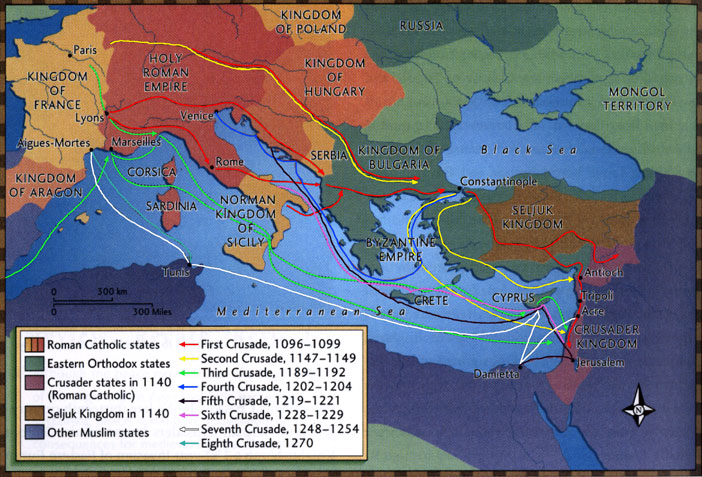
Routes Crusaders took from Europe to the Holy Land showing all eight Crusades

Crusader States
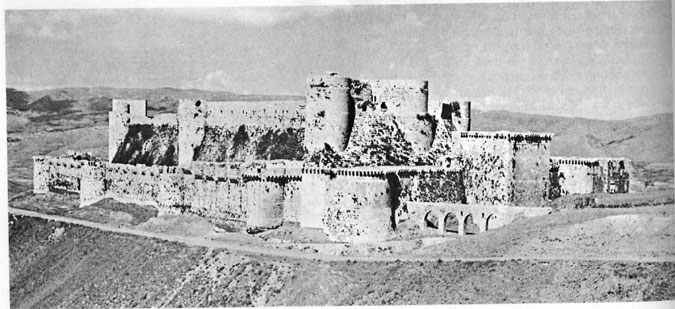
Knights' Castle
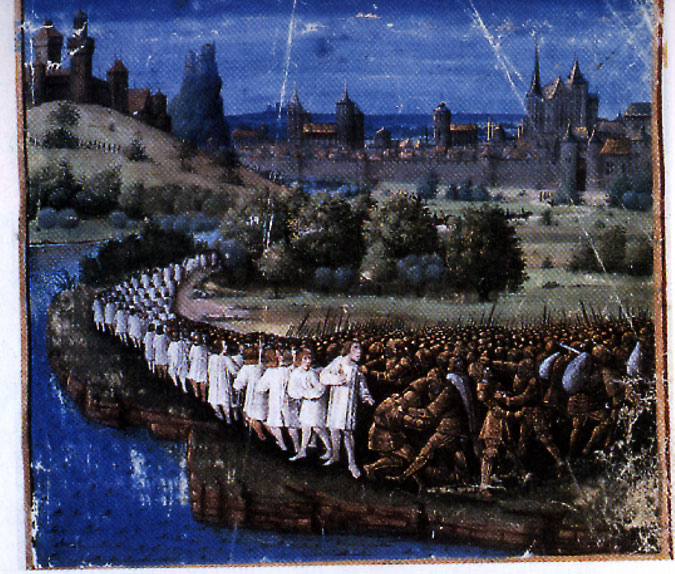
Hungarians Fight Crusaders to try to reclaim their stolen property
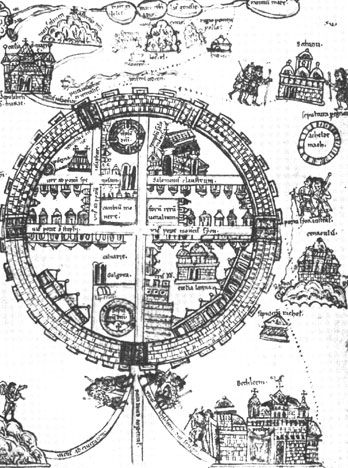
Crusaders' Map of Jerusalem

Jerusalem in the 1300’s
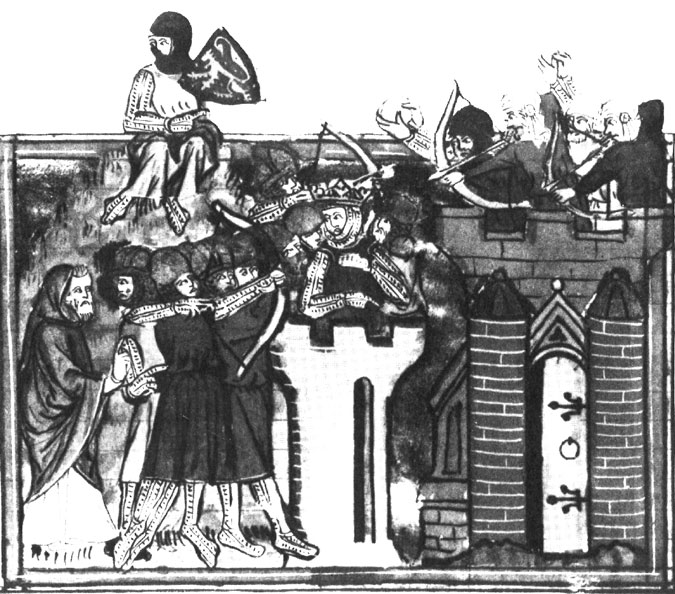
Crusaders attack Jerusalem in 1099. On the far left is Peter the Hermit.






